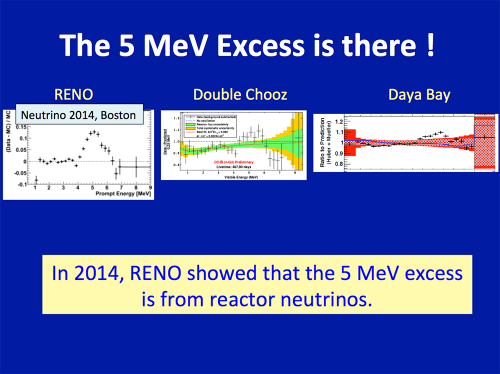Tag archives: Neutrino 2016
Neutrinos that go bump in the night

Triple bump: the 5 MeV bump data presented by K Joo at the Neutrino 2016 conference. (Courtesy: RENO Collaboration)
By Tushna Commissariat
A final mystery that was mentioned at the Neutrino 2016 I attended in London this week was yet another unexpected “bump” in data at 5 MeV, measured while monitoring the neutrino flux from nuclear power plants. Starting with the RENO experiment in 2012, it was spotted by the Double Chooz experiment in 2014 and finally by the Daya Bay neutrino experiment earlier this year. While the initial signal was not of high enough statistical significance, it has now held up over time and more measurements.
Limiting factors for the elusive sterile neutrino
By Tushna Commissariat
More data are definitely needed in the quest for the sought-after sterile neutrino. That much was clear as more than 10 different global neutrino detectors announced at the Neutrino 2016 conference in London that they have found no evidence for the slippery particle’s existence. The sterile neutrino is a hypothetical and much-debated fourth type of neutrino that would contribute mass, but only interact with the other three “active neutrinos”, making it that much more difficult to detect. In the video above, Physics World features editor Louise Mayor explains why researchers are so keen to nail down this particle, should it exist, as it may single-handedly explain some of the biggest mysteries in physics today, including dark matter.
View all posts by this author | View this author's profile
Symmetry-violating neutrinos may hold the key to antimatter

Deep trap: Inside the Super-Kamiokande neutrino detector. (Courtesy: T2K Collaboration)
By Tushna Commissariat
As you may have read, earlier this week I was at Neutrino 2016 – the 27th International Conference on Neutrino Physics and Astrophysics – in London. Although I was only at two days of the week-long conference, I still have neutrinos on my mind. A whole host of experiments presented various data and updates. Indeed, the researchers presenting the latest results from the Tokai to Kamioka (T2K) experiment in Japan and the NOvA Neutrino Experiment at Fermilab in the US had some interesting things to say.
T2K collaborator Hirohisa Tanaka, from the University of Toronto in Canada, revealed that the experiment’s most recent data seem to support earlier hints that there may be different oscillation probabilities for neutrinos and antineutrinos. If these data hold up, then it would have big consequences – the standard model of neutrino physics says that these two oscillation rates should be the same so as not to violate charge–parity (CP) symmetry. According to the collaboration, their observed “electron antineutrino appearance event rate is lower than would be expected based on the electron neutrino appearance event rate, assuming that CP symmetry is conserved”.